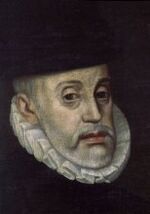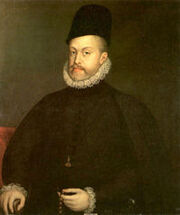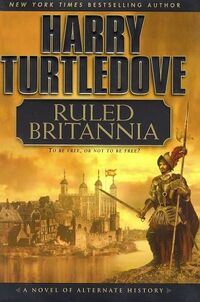| ||||||||||||||||||||||||||||||||||||||
Philip II (21 May 1527 – 13 September 1598), Felipe in Spanish, sometimes called Philip the Prudent, was King of Spain from 1556 until 1598, King of Naples from 1554 until 1598, lord of the Seventeen Provinces from 1556 until 1581, holding various titles for the individual territories, such as duke or count; and King of Portugal and the Algarves as Filipe I from 1580. During his marriage to Queen Mary I (1554–58), he was also King of England and Ireland. He also ruled a vast empire in the Americas, including New Spain and Peru. Indeed, during his reign, Spain's position as a global empire reached its zenith. Philip also took notable military actions against England.
Philip II in Ruled Britannia
Fueled by Catholic beliefs, Philip II had already built up a considerable empire for Spain in his career. Naturally, many of his foreign subjects were resistant to Spanish rule. This was especially true in the Netherlands, where Spain found itself engaged in an ongoing war against an intractable Protestant Dutch nationalist resistance.
In 1585, support for the rebels by English Queen Elizabeth gave Philip a long desired causus belli against England. In 1588, Philip assembled and dispatched the Spanish Armada, which defeated the English fleet, relieved a second Spanish fleet which had been hemmed in by a Dutch blockade, and landed a Spanish army on English soil (thus earning Philip a million gold ducats from the Vatican treasury, a sum promised to him by Pope Gregory XIII in exchange for overthrowing Elizabeth, and paid by Gregory's successor, Sixtus V). The Spanish army defeated its amateur English counterpart and deposed Elizabeth, imprisoning her in the Tower of London. Philip ordered that Elizabeth be kept alive, but made it clear that he did so out of mercy, that he would be justified in killing Elizabeth as vengeance for her own execution of the Catholic Mary Queen of Scots.

Philip II in his final years.
Philip installed his daughter, Isabella, and her husband (also first cousin), Albert, as Queen and King of England. He maintained a large Spanish military presence in England to support this Hapsburg dynasty throughout the remainder of his life.
He died after a long illness in September 1598, and was succeeded by his son, the young and far less capable Philip III. The English playwright William Shakespeare had been contracted to write an English-language play called King Philip to glorify Philip II's life and achievements and inspire loyalty to the Spanish Empire on the part of its English subjects. However, Shakespeare instead performed the English nationalistic play Boudicca, which inspired his English audience to overthrow Isabella and Albert and expel Spanish forces from England.
| Royal offices (OTL) | ||
|---|---|---|
| Preceded by Carlos I |
King of Spain (among other titles) 1556-1598 |
Succeeded by Philip III |
| Preceded by Mary I as sole monarch |
King of England and Ireland (jure uxoris) 25 July 1554 – 17 November 1558 with Mary I |
Succeeded by Elizabeth I |
| Preceded by Henrique I |
King of Portugal (as Philip I) 1580-1598 |
Succeeded by Philip II |
| ||||||||||
| |||||||||||||||||||||||
| |||||||||||||||||||


